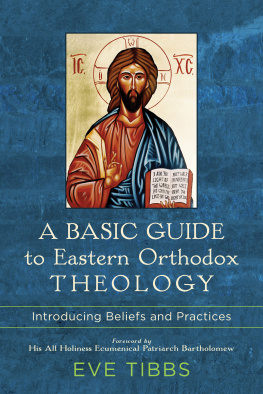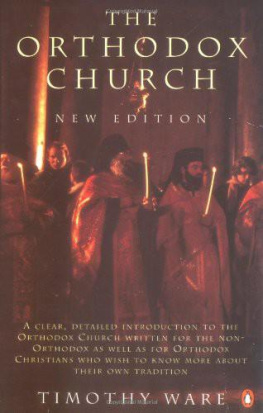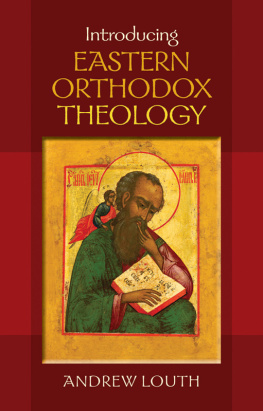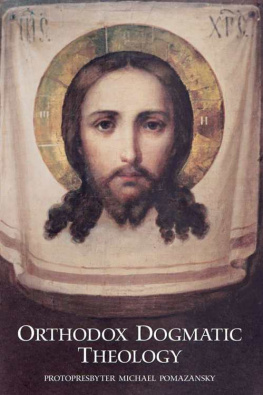Contents
Cover
Endorsements
Half Title Page
Title Page
Copyright Page
Dedication
Foreword by His All Holiness Ecumenical Patriarch Bartholomew
Preface
The Origins of This Book
The Intended Audience for This Book
How This Book Should Be Read
Acknowledgments
Introduction
Assumptions and Terminology
The Approach
Change?
1. The Orthodox Christian Worldview
Returning to the Unknown Ancient Church?
The Orthodox Church in the Christian World
East Is East and West Is West
The Primacy of Worship
Come and See!
Doing Theology in Orthodox Christianity
2. The Church
Joined Together in the Church
What Is the Church? Where Is the Church?
The Orthodox Church Today
What Is This Rock?
One, Holy, Catholic, and Apostolic
What Holds the Orthodox Church Together?
Communion and Conciliarity
Holy Tradition
The Eikn
Holy Scripture
Holy Icons
4. Ministry and Leadership
The Royal Vocation of All People
First among Equals
Three Orders of Clergy
Ordination of Women
Apostolic Succession
5. Christology
The Word of God Is a Person
Who Is Jesus?
Early Challenges to Christology
The Rule of Truth
Error and Heresy
Christology and the Ecumenical Councils
Singing Theology
6. Who Are We? What Are We to Do?
Created for Communion
Tragedy in the Garden
Being Saved
Theosis
All Creation Rejoices
Humanity, We Have a Problem
The Cross and Resurrection
7. The Holy Trinity
The Revealed Trinity
Trinitarian Taxis
The Cappadocian Settlement: One Essence and Three Persons
The Holy Spirit
The Church as an Icon of the Trinity
Liturgy
An Earthly Heaven
Relevant and Ancient
The Holy Mysteries
Epilogue
Appendix: Excerpts from Selected Apostolic and Patristic Writings
Excerpts from the Epistle of St. Ignatius to the Philadelphians
Excerpts from the Epistle of St. Ignatius to the Smyrnaeans
Excerpts from Against Heresies 3.3 by St. Irenaeus, Bishop of Lyons
Full Text of The Didache: The Lords Teaching through the Twelve Apostles to the Nations
Glossary of Orthodox Terms
Index
Back Cover

Foreword
Grace and peace from God to the esteemed readership of this publication, beloved brethren and children in the Christ Jesus, our Lord.
Jesus Christ is the same yesterday, today, and forever.
(Hebrews 13:8)
As He is the same yesterday, today, and forever, so too is His Holy Body, the One, Holy, Catholic, and Apostolic Church. Often in bumper stickers displayed by some Orthodox Christians in the United States appears the phrase, The Orthodox Church: Founded in 33 A.D. This claim may appear oversimplistic and hyperbolic, but it still reflects the reality that those local churches that today call themselves Orthodox have a strong awareness about their close ties and their uninterrupted continuity with the origins and beginnings of Christianity in the ancient Eastern Christian centers in Middle East, Asia, and Northern Africa.
However, despite the fact that the Orthodox Christian Faith is today practiced in every corner of the world, with more than 250 million adherents worldwide, its rich history, beliefs, practices, and spirituality remain largely unfamiliar to many in the West. Even in regions where Orthodox Christians are relatively numerous, Orthodox Christianity, which has played an integral role in the development of civilization as we know it today, still is perceived as an exotic and picturesque remnant from an alien past.
If the Orthodox Church were approached only from the perspective of its history and institutions, it could indeed appear foreign and fragmented to an outsider. For this reason, we take great pleasure in recommending this publication, titled A Basic Guide to Eastern Orthodox Theology: Introducing Beliefs and Practices , because it does not follow the abovementioned approach, but, instead, its perception is molded by the authors experience of the Orthodox sacramental life, its life of worship. The very word orthodoxy means both holding the right beliefs and also right worship and practice, the proper way of giving glory () to God, the communication of the basic truths of the Christian faith in ways that go beyond mere words and are readily accessible to everyone.











